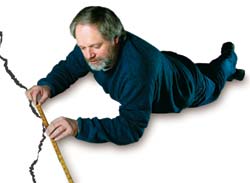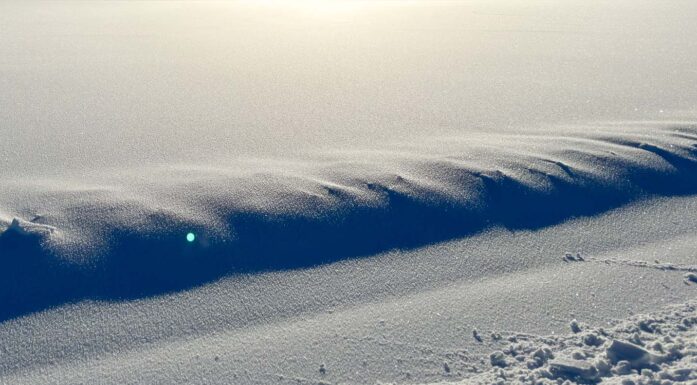Magiske 0,8
What do cement floors, earthquakes and broken cups have in common? A magic number.
In 1975, the Polish-born mathematician Benoit Mandelbrot made a sensational discovery: when he broke aluminium poles of different thicknesses in half and examined the fracture surfaces on the poles, he discovered to his astonishment that the same fracture patterns appeared again and again, regardless of the fracture surface size. At the beginning of the 1990s, two groups of physicists independently published new research results, advancing Mandelbrot’s observations.
Their results not only showed that the same patterns appeared no matter the size, but that they were governed by one specific, ‘magic’ number or mathematical constant that the researchers claimed applied to all brittle materials. Whether a brick cut in half, or a mountain crack, the fracture pattern could be described with the same number: 0.8. The researchers claimed that if they used this number in a certain formula, they could calculate the behaviour of cracks in all brittle materials, such as brick walls, cast-iron and porcelain.
Their claim was based both on experiments and on numerical calculations made with computer models. In spite of the empirical data, no one could offer a deep, theoretical understanding of this discovery. In subsequent years, many scientists tried to explain the theory behind this magic number, but up until recently, nobody had been able to crack the code.
CALCULATIONS
Professor Alex Hansen, now a physicist in NTNU’s Physics Department, participated in this pioneering work in the 1990s. Today the professor and two French research colleagues claim they have finally found the answer as to how this ‘magic’ number came into being. For the first time, researchers have managed to calculate the number they have previously seen only in experiments.
Researchers at the University of Oslo have conducted the physical experiments that support the theory. Some pieces are still missing from the puzzle, but the most important evidence is in Professor Hansen’s hands. The results have gained international attention and have been published in the renowned journal Physical Review Letters.
FRACTURE HERESY
Scepticism about the new idea is still widespread among those who have traditionally worked with fracture surfaces – mechanical engineers. Prof. Hansen says that the claim that certain characteristics remain the same, regardless of the material, is heresy in traditional fracture research. Nevertheless, the theory has gradually been accepted by researchers all over the world. In fact, Prof. Hansen has been asked to arrange a symposium about the findings at a large, international conference on fractures in Italy in 2005, arranged by mechanical engineers.
Professor Hansen says the most important aspect of these discoveries is that they allow for the transfer of results from laboratories to full-scale systems. For example, how do you transfer the results from metal plates measuring 20×20 cm to plates measuring 20×20 metres? This problem of upscaling is very old and, according to Prof. Hansen, it will continue to be a major and important challenge.
PREDICTS SHAPE
What happens when a material is exposed to external stress? When will it crack? Where will the crack develop and where will it end? What will it look like? In order to conduct the numerical experiments needed to answer these questions, Prof. Hansen has employed what physicists call a fuse model. A network of fuses – the same fuses found in your fuse box – is arranged much like an advanced computer program.
The fuses can take varying amperage, and as the current is increased, the smallest fuses blow, forcing the current to find its way around the broken fuses. That increases the pressure on the other fuses, and they blow as well. Finally, the entire network breaks down. The fuses represent strong and weak areas in a material and make it possible to predict the shape of the cracks. In brittle materials, the process happens like this: Numerous micro cracks develop gradually in the material.
These micro cracks will change the distribution of forces in the material, and these forces cause new micro cracks. Hence, there is a circular connection between the micro cracks and the forces, and eventually, the material cracks. This circular connection takes complete control and overrides specific fracture characteristics of different materials. Thus, the characteristics of each material become irrelevant, making the same magic number applicable to all brittle materials.
HELP FOR EARTHQUAKE RESEARCHERS
The discovery makes it possible to transfer small-scale laboratory tests to large-scale reallife situations. For example, the theory can give seismologists a better understanding of how faults (cracks in the Earth’s crust) behave during earthquakes, and therefore can contribute to a more accurate warning of seismic dangers. In September 2004, Kobe, Japan was struck by two earthquakes.
The first quake was measured at 8.0 on the Richter scale and was the most powerful earthquake in Japan for almost nine years. Measurements conducted after the quake showed that the faults behaved according to the theory developed by Hansen and his French colleagues. Earthquakes mainly occur on the border between the plates of the Earth’s crust. Tensions between these plates are highly affected by their roughness (the shape of their fracture surfaces) and by the stress peaks they create.
“Our research makes it easier to understand this roughness, and beyond that, the processes triggering earthquakes. By measuring the tensions in a given area,we can predict the tension other places along the fault. Knowing this, we will be able to predict where an earthquake of a given strength will occur. This could be invaluable knowledge to future seismologists,” concludes Hansen.
Elin Fugelsnes





